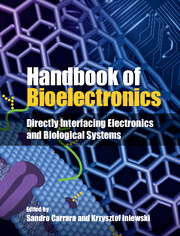Book contents
- Frontmatter
- Contents
- List of Contributors
- 1 What is bioelectronics?
- Part I Electronic components
- Part II Biosensors
- Part III Fuel cells
- Part IV Biomimetic systems
- Part V Bionics
- 22 Introduction to bionics
- 23 Bioelectronic interfaces for artificially driven human movements
- 24 The Bionic Eye: a review of multielectrode arrays
- 25 CMOS technologies for retinal prosthesis
- 26 Photovoltaic retinal prosthesis for restoring sight to the blind
- Part VI Brain interfaces
- Part VII Lab-on-a-chip
- Part VIII Future perspectives
- Index
- References
25 - CMOS technologiesfor retinal prosthesis
from Part V - Bionics
Published online by Cambridge University Press: 05 September 2015
- Frontmatter
- Contents
- List of Contributors
- 1 What is bioelectronics?
- Part I Electronic components
- Part II Biosensors
- Part III Fuel cells
- Part IV Biomimetic systems
- Part V Bionics
- 22 Introduction to bionics
- 23 Bioelectronic interfaces for artificially driven human movements
- 24 The Bionic Eye: a review of multielectrode arrays
- 25 CMOS technologies for retinal prosthesis
- 26 Photovoltaic retinal prosthesis for restoring sight to the blind
- Part VI Brain interfaces
- Part VII Lab-on-a-chip
- Part VIII Future perspectives
- Index
- References
Summary
This chapter describes retinal prosthetic devices that are used withcomplementary metal oxide semiconductor (CMOS) technologies or large-scaleintegration (LSI) circuit technologies. The introduction of CMOStechnologies has made retinal prosthesis systems compact and versatile.Moreover, CMOS technology is particularly effective for increasing thenumber of stimulus electrodes with limited wiring. The remainder of thischapter is organized as follows. In Section 25.1, the principle of theretinal prosthesis and its basic components are discussed. In Section 25.2,various types of retinal prostheses are described. In Section 25.3, multiplemicrochip architectures that can realize a large number of stimuluselectrodes are introduced and demonstrated in detail. In Section 25.4integration of a photosensing function in a retinal stimulator is discussed.Finally, Section 25.5 proposes a smart electrode as an avenue for futureresearch in retinal prostheses. A preliminary demonstration isdescribed.
Principle and basic components of the retinal prosthesis
The front end of visual information is the retina. The human retina is athin, layered tissue with a thickness ranging from 0.1 to 0.4 mmattached to the inner surface of the eyeball [1], as shown in Figure 25.1.The retina has a layered structure with photoreceptor cells for lightdetection in the bottom layer and ganglion cells for output in the toplayer. The retina plays an important role in visual information collectionand processing, and so its dysfunction can result in blindness. Amongblindness diseases, retinitis pigmentosa (RP) and age-related maculardegeneration (AMD) have no effective remedies at present. In both cases, thephotoreceptors gradually become dysfunctional, so that the patienteventually becomes blind. However, some portion of ganglion cells remainsalive [2]. Consequently, by stimulating the remaining retinal cells, visualsensation or phosphenes can be evoked. This is the principle of the retinalprosthesis or artificial vision. Based on this principle, a retinalprosthetic device stimulates retinal cells with a patterned electricalsignal so that a blind patient can sense a phosphene pattern, or somethinglike an image. Stimulating the optic nerve and the visual cortex can alsorestore visual sensation, but this would require more complicated surgicaloperations.
Information
- Type
- Chapter
- Information
- Handbook of BioelectronicsDirectly Interfacing Electronics and Biological Systems, pp. 313 - 324Publisher: Cambridge University PressPrint publication year: 2015
